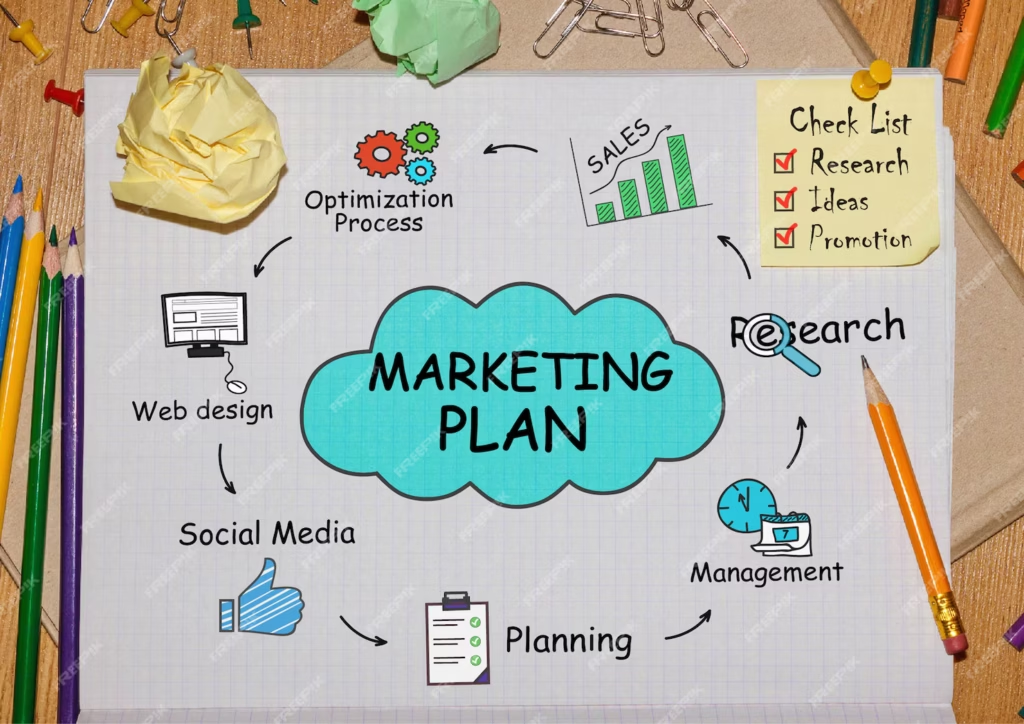1. Introduction
“How to Create a Marketing Plan for Your SMB Website”—it’s a question that resonates loudly if you’re running a small or medium-sized business (SMB). In a world where digital marketing and constant online engagement rule, developing a coherent, strategic marketing roadmap can spell the difference between gradual stagnation and accelerated success. Imagine reeling in the right audience, guiding them through a carefully designed funnel, and converting them into loyal, paying customers—all thanks to a purposeful marketing plan that caters to every stage of your client’s awareness.
In this extensive guide, we’ll clarify why a marketing plan isn’t just a “nice-to-have” but rather the structural backbone of your online presence. We’ll dig into how a marketing plan fuses design, marketing, development, and SEO into an orchestration that captures leads and drives conversions daily. We’ll also map out how each awareness level—from Unaware to Most Aware—demands different content, strategies, and calls-to-action (CTAs). Finally, we’ll reference high-competition keywords like “web design agency,” “SEO services,” “digital marketing company,” “responsive design”, and moderate-competition terms such as “ready-made websites for small businesses,” “affordable website solutions,” “local SEO strategies,” “conversion optimization tips” to ensure your site attains top placement on Google, Bing, Yahoo, and Yandex.
If you’re an SMB that’s short on time, staff, or big corporate budgets, but you still want to scale your digital presence, keep reading. By implementing the steps in this article, your marketing plan can transform a generic or struggling site into a powerful brand asset generating leads, boosting customer loyalty, and cultivating sustainable revenue streams. Let’s dive in!
2. Why Every SMB Needs a Marketing Plan for Their Website
Some small business owners presume a marketing plan is either too expensive, too time-consuming, or simply unnecessary if you have decent traffic. But in a global digital market—where search results can make or break discovery—a marketing plan is mission-critical. Here’s why:
2.1 Strategic Direction: Know Where You’re Headed
• Avoid Random Tactics: Without a plan, your social media, email campaigns, or SEO efforts might be uncoordinated or repetitive.
• Set Measurable Goals: Outline monthly or quarterly KPIs (visits, leads, sales, etc.) to keep your site performance on track.
• Target the Right Audience: Identify buyer personas, then tailor your approach to meet their actual needs instead of guessing.
2.2 Consistent Brand Messaging: Build Trust and Recognition
• Unified Voice: A plan ensures your brand identity, tone, and visuals align across channels—website pages, blog posts, email sequences, or social media.
• Customer Loyalty: Familiar brand cues and consistent messaging foster emotional bonds, encouraging repeat business.
2.3 Funnel Alignment: Catering to Different Awareness Levels
• Lead Generation: By mapping content to the funnel (TOFU, MOFU, BOFU), you effectively nurture visitors from Unaware to Most Aware.
• High Conversion Rates: When site features and content match each awareness level, friction decreases, boosting conversions.
2.4 Competitive Advantage
• Outrank Bigger Rivals: Even with smaller budgets, a savvy marketing plan can help your site appear for high-traffic and moderate-competition keywords—e.g., “digital marketing company,” “ready-made websites for small businesses.”
• Customer-Centric Strategy: Targeted campaigns resonate better than generic approaches, especially for niche local markets.
Simply put, a marketing plan orchestrates all site-related efforts—design, marketing, development, and SEO—to magnify brand impact and ROI.
3. Laying the Groundwork: Understanding the Client Awareness Funnel
Before building any plan, internalize the client awareness funnel. Not all visitors are equally informed or motivated—they exist at varying readiness stages, from oblivious about their problems to actively seeking to purchase your solutions. Effective marketing meets them where they are:
3.1 Unaware (TOFU)
Definition: Prospects have no clue they even need your product or service.
Goal: Plant a seed—educate them about a potential problem or new insight.
Content Types: Broad, curiosity-provoking blog posts, infographics, short “did you know?” videos.
3.2 Problem-Aware (TOFU)
Definition: Prospects realize they have a specific issue (e.g., poor branding or a slow website) but no solution.
Goal: Position yourself as a thought leader highlighting potential solutions or next steps.
Content Types: “Top 5 UI Mistakes,” “How to Speed Up a Site,” or “Why Branding Matters for SMBs.”
3.3 Solution-Aware (MOFU)
Definition: Prospects know solutions exist (like hiring an agency, using a certain software) but haven’t chosen one.
Goal: Demonstrate your unique approach—why your expertise or offering outshines competing services.
Content Types: Comparisons, product demos, e-books, or relevant case studies.
3.4 Product-Aware (BOFU)
Definition: Prospects specifically know about your service and are weighing it against other options.
Goal: Address concerns, highlight success stories, and prove ROI to close the deal.
Content Types: In-depth pricing pages, free trials, customer testimonials, “why us” pages.
3.5 Most Aware (BOFU)
Definition: Ready to buy; only minor doubts or clarifications remain.
Goal: Smooth the final step with direct CTAs, discount codes, or limited-time promos.
Content Types: “Sign Up Now,” “Claim Your Discount,” “Launch Your Project Today.”
Your marketing plan must systematically guide visitors from Unaware to Purchase, ensuring each site section and piece of content meets them at the right moment.
4. Step-by-Step: How to Create a Marketing Plan for Your SMB Website
Now that you grasp the funnel’s importance, let’s outline a comprehensive marketing plan bridging design, marketing, development, and SEO. Think of this as your blueprint to orchestrate brand synergy, user engagement, and conversions.
4.1 Step 1: Conduct a Brand Audit
Why: A solid marketing plan rests on a consistent, resonant brand identity. If your brand visuals, voice, or offline materials clash, prospective clients experience confusion or mistrust.
Tasks:
• Assess color schemes, logos, fonts, messaging on your existing site
• Compare offline branding (store signage, business cards) with digital assets—do they match your intended brand vibe?
• Gather feedback from loyal customers about brand impressions, gleaning real-world insights
Outcome: A definitive brand style guide that unifies design elements—ensuring each marketing campaign or site update remains visually and tonally consistent.
4.2 Step 2: Define Objectives and Buyer Personas
Why: Clarity on who you’re targeting and what you want to accomplish sets the direction for all marketing efforts.
Tasks:
• Outline goals: e.g., a 50% increase in monthly leads, a 20% jump in e-commerce sales, or double your local brand searches.
• Identify buyer personas: Are they young professionals seeking affordable solutions, or older homeowners needing high-end finishes?
• Align brand voice: A tech-savvy audience might prefer a modern, playful tone, while local artisanal buyers might want a personal, folksy vibe.
Outcome: A clear “North Star” for your marketing plan—defining success metrics and audience segments you’ll tailor content for.
4.3 Step 3: Craft Funnel-Aligned Content for Each Awareness Stage
Why: Different content resonates with visitors who are Unaware, Problem-Aware, Solution-Aware, Product-Aware, or Most Aware. Failing to segment your site content might alienate or confuse them.
Tasks:
• TOFU (Unaware/Problem-Aware): Educational blog posts, short “did you know” reels, infographics. Example topics: “Why Quality Branding Makes or Breaks SMBs,” “Top 5 UI Mistakes.”
• MOFU (Solution-Aware): E-books, in-depth guides, or case studies that highlight your unique approach or success stories—like “How We Redesigned Site X for 2x Conversions.”
• BOFU (Product-Aware/Most Aware): Detailed pricing pages, free trial sign-ups, or direct “Buy Now” forms. Emphasize testimonials or ROI-driven proof to close deals.
Outcome: A site that naturally funnels visitors from broad awareness content to deeper solution or product pages, culminating in a confident buying decision.
4.4 Step 4: Optimize On-Page SEO (Mix of High and Moderate-Competition Keywords)
Why: Even a perfect funnel fails if prospects can’t find your site. Balancing high-competition terms for broad exposure and moderate-competition terms for quicker wins cements consistent traffic flow.
Tasks:
• Keyword Research: Tools like SEMrush, Ahrefs, or Google Keyword Planner to find relevant queries—like “web design agency,” “SEO services,” “ready-made websites for small businesses,” “conversion optimization tips.”
• Meta Data Optimization: Craft unique, engaging title tags (~60 characters) and meta descriptions (~155 characters) referencing your chosen keywords.
• Header Tag Usage: Insert relevant terms in H1, H2, H3 headings to guide search crawlers and readers.
• Content Depth: Write thorough blog posts, landing pages, or product descriptions that answer user queries in-depth, encouraging dwell time and boosting SEO signals.
Outcome: Enhanced SERP rankings, positioning your brand front and center for both widely sought terms and more niche queries.
4.5 Incorporate Social Proof and Trust Signals
Why: In digital contexts, intangible trust markers—like reviews or recognized payment logos—often make or break purchase intent.
Tasks:
• Testimonial Integration: Showcase real client quotes on your homepage or relevant product/service pages.
• Star Ratings: If you have reviews on Yelp or Google My Business, embed them near CTAs.
• Security Credentials: Display SSL badges, recognized payment icons (PayPal, Visa, MasterCard) to reassure potential buyers of safe transactions.
Outcome: Increased user confidence, mitigated doubts about credibility, and smoother bottom-of-funnel conversions.
4.6 Create a Seamless User Experience (UX)
Why: Even strong content flops if the site design is confusing or cluttered. Achieving a fluid user journey is vital to funnel completion.
Tasks:
• Simplify Navigation: Group similar pages logically, ensure your top nav is clear and uncluttered.
• Strategic CTA Placement: Key buttons or forms should appear above the fold, and possibly repeated further down.
• Responsive Layouts: Test your site on multiple devices, ensuring no broken layout or hidden CTA blocks.
Outcome: Visitors find the info they need quickly, remain engaged longer, and more readily convert into leads or customers.
4.7 Implement Lead Capture Forms and Nurture Sequences
Why: Some visitors won’t buy immediately—perhaps they’re just comparing solutions. Capturing their details allows you to continue the conversation.
Tasks:
• Provide Incentives: E-book downloads, exclusive discounts, or a free mini-consultation in exchange for contact info.
• CRM Integration: Each form submission flows into your CRM, automatically segmenting leads by funnel stage or interest.
• Follow-up Emails: A short drip campaign can share case studies or blog posts, softly encouraging them down the funnel.
Outcome: Instead of losing casual visitors, you grow a lead list that can be nurtured toward final purchase decisions.
4.8 Track and Refine with Analytics
Why: Marketing is iterative. Data from Google Analytics, Search Console, or heatmaps indicates what’s effective and what needs rethinking.
Tasks:
• Event Tracking: Monitor CTA clicks, form completions, cart adds, or video views.
• A/B Testing: Compare variations of CTA text, color schemes, or blog headlines to see what yields better engagement.
• Goal Conversions: Set up metrics for sign-ups, purchases, or downloads—pinpointing your ROI from marketing efforts.
Outcome: A dynamic, data-driven marketing plan that grows stronger with each iteration, ensuring your site remains relevant and profitable.
5. Realign with Nveil: Why Our Approach Works
Nveil specializes in bridging design, marketing, development, and ready-made website solutions. But what sets us apart is our funnel-first approach—ensuring every design choice or marketing tactic feeds into a coherent brand narrative that resonates with each buyer stage. Key elements of our process:
• Holistic Audits: We begin by examining your brand identity, site performance, competitor landscape, and funnel integration. This big-picture perspective avoids disjointed or redundant fixes.
• Brand-Consistent Visuals: From color palettes to layout structure, we ensure your digital persona seamlessly matches offline branding, forging trust and recognition.
• Targeted SEO Implementation: Our teams interweave high-competition keywords (like “SEO services,” “digital marketing company”) with moderate-competition ones (“ready-made websites for small businesses,” “conversion optimization tips”) in content, meta tags, and site copy.
• Technical Excellence: Clean, secure code, fast load times, mobile responsiveness, and built-in analytics let your SMB shine online.
Result: A site that doesn’t just look appealing—it systematically generates leads and nurtures them until they’re ready to buy.
6. Practical Tips for SMB Website Marketing Success
If you’re already an SMB operator wanting quick wins, we’ve compiled additional tactical pointers you can deploy swiftly:
6.1 Use High-Visibility CTAs
• Place your main CTA (e.g., “Request a Quote,” “Get a Free Audit”) in the top-right corner of the header and repeat it near relevant content sections.
• Test different button colors—contrasting with your brand palette without clashing—like bright orange or deep teal that grabs attention.
6.2 Build a Resource Library
• Host in-depth e-books, whitepapers, or even short PDF guides that require an email form to access—valuable for lead generation.
• Label each resource with funnel alignment: a broad “Why Good Design Matters” PDF for Unaware leads, or an advanced “Evaluating Web Design Proposals” e-book for MOFU readers.
6.3 Integrate Chat Support or Chatbots
• Offer immediate answers to questions, bridging Problem-Aware prospects to solutions.
• Keep chat unobtrusive but visible—like a subtle icon in the bottom-right corner. Let visitors initiate the conversation for a frictionless approach.
6.4 Offer a Freemium or Trial Option
• If relevant, a free sample or limited version of your service can convert uncertain visitors into engaged leads, especially in mid-funnel stages.
• Emphasize the brand synergy—packaging or site visuals must reflect the “taste” of your full offerings, encouraging a full purchase or upgrade.
6.5 Local SEO Tactics for Physical-Store SMBs
• Register or update Google Business Profile (formerly GMB). Encourage customers to leave Google Reviews.
• Embed a Google Map on your “Contact” page, listing an exact address and store hours.
• Use location-specific keywords in meta titles—e.g., “Best Cupcakes in Chicago: [Your Bakery Name].”
6.6 Encourage User-Generated Content
• Let visitors post reviews, photos, or testimonials on your site or social media. People trust real experiences from fellow customers.
• Re-share the best user-generated content in newsletters or social posts, enhancing brand credibility while reducing your content load.
6.7 Maintain a Regular Update Schedule
• Google (and returning users) appreciate fresh content—aim for at least monthly blog posts or new product showcases.
• Seasonal tie-ins (holiday themes, year-end promos) keep content relevant and timely.
7. Measuring and Refining Your Marketing Plan
A successful marketing plan for your SMB website isn’t static; it’s a living framework. Monitoring user interactions, SERP changes, and conversion patterns helps you refine strategies, ensuring consistent improvement. Key elements include:
7.1 Analytics and KPI Tracking
• Google Analytics: Evaluate page views, bounce rates, session durations, and conversion funnels.
• Search Console: Inspect keyword queries, indexing issues, or potential site errors harming visibility.
• CRM Metrics: If you gather leads, track how many convert over time or require additional nurturing.
7.2 A/B Testing and Iteration
• CTA Variations: Experiment with different button texts or color contrasts to find the best performing approach.
• Landing Pages: Run split tests on headings, images, or form lengths. High-competition keywords may yield many visitors, making it easier to glean data quickly.
• Email Subject Lines: Identify what resonates best with your subscribers—playful, direct, or urgent tones.
7.3 Continuous Keyword Monitoring
• Check how your chosen high-competition terms (like “web design agency” or “SEO services”) and moderate-competition ones (like “ready-made websites for small businesses”) rank over time.
• Tweak site copy, meta tags, or blog topics to capture new phrases or adapt to search algorithm changes.
7.4 Regular Content Audits
• Outdated or underperforming posts can be updated or consolidated.
• Pages with low dwell times might need better visuals, more in-depth info, or improved layout to re-engage visitors.
Result: A site that continues to evolve in step with user expectations, ensuring you stay one step ahead of a constantly shifting digital environment.
8. Case Study: An SMB’s 150% Increase in Leads with Funnel-Centric Marketing
Scenario: “EcoLiving Consultants,” a small environmental consulting firm, lacked a structured marketing plan. Despite an okay website and relevant services, lead volume was low. The brand vibe was inconsistent, and the site offered minimal funnel-stage content. With Nveil’s guidance, they implemented a comprehensive marketing plan focusing on brand cohesion, funnel alignment, user experience, and a balanced SEO approach.
8.1 The Overhaul
• Brand Consistency: Refined color palette (earthy greens, browns), updated their understated logo, and created a consistent font scheme across the site.
• Funnel-Aligned Content: TOFU blog articles on sustainable business practices, MOFU e-books (“How to Reduce Carbon Footprint at Your Workplace”), and BOFU pages offering free initial audits or direct CTA sign-ups.
• SEO & Keyword Balance: Targeted moderate-competition phrases like “eco-friendly consulting for SMBs,” along with references to high-competition terms such as “SEO services” or “digital marketing company” in secondary mentions or case studies.
• Tech & UX Upgrades: Compressed images, improved mobile layouts, integrated trust signals (certifications, star ratings), installed analytics for continuous refinement.
8.2 Measurable Results
• Lead Volume soared by 150% over six months, with form inquiries climbing significantly.
• Organic Visibility: They rose from page 4 to page 1 for local terms like “sustainable consulting near me.”
• Bounce Rate dropped from 62% to 38% after the site’s UI/UX improvements.
• New Partnerships: Other local sustainability initiatives discovered EcoLiving via their advanced funnel content, leading to joint ventures and local press coverage.
Key Insight: A brand-forward marketing plan that leverages funnel staging, SEO best practices, and user-friendly site design can dramatically amplify lead counts and brand authority—even for niche service providers.
9. Conclusion: A Marketing Plan for Sustainable Online Growth
For SMBs striving to cut through digital noise, user-friendly design and a robust marketing plan is non-negotiable. By merging design, marketing, development, and SEO into a holistic framework—and structuring content to cater to each buyer awareness stage—your website evolves into a self-sustaining funnel, guiding visitors from passive browsers to loyal customers.
At Nveil, we orchestrate these elements—aligning brand identity with strategic marketing funnels, ensuring your site loads fast, remains secure, and integrates both high-competition keywords and moderate-competition terms for maximum SERP exposure. The result? A site that not only impresses but also sells, driving meaningful leads and revenue in an era where digital presence reigns supreme.
Whether you’re building from scratch or revamping an outdated site, a structured marketing plan is your map to stand-out success, bridging offline brand strengths with targeted online opportunities. Launch your SMB’s online growth today—by prioritizing a funnel-informed, user-centric website that underscores your brand’s unique promise. Embrace data-driven refinement, watch your lead pipeline expand, and see your market influence thrive, one funnel-aligned step at a time.



